Chinese New Year Snacks
Categories:
Inspiration
Chinese New Year is the most important holiday in Chinese culture.
The most important meal of the year is the New Year’s Eve reunion dinner
(年年夜饭—Nián yèfàn or 团年年饭—tuán niánfàn). No matter where they live,
all family members must return to their hometown. If they truly can’t, the rest
of the family will leave their spot empty and place a spare set of utensils for them.
In the legend of the Spring Festival’s origin, this was when the monster Nian would
come and terrorize the villages. The people would hide in their homes, prepare
a feast with offerings to the ancestors and gods, and hope for the best.
This is the most important meal of the year. But the Spring Festival is 15 days long!
It’s the longest holiday and people take advantage of the break. In the lull between
activities and celebrations, people will just relax at home and watch TV.
And that means snacks. Of course, everyone has their own favorite snacks.
Here are a few that are popular and commonly seen.

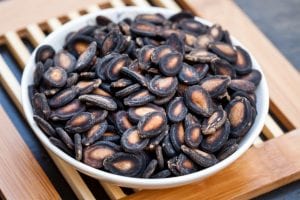
Baked Seeds ⽠瓜⼦子 (guā zǐ)
Eating baked seeds is a favorite pastime of most Chinese. They even have a term specifically for the act of cracking the seed open with your teeth and eating it—嗑 (kē). No matter where they are, they can take out a handful of seeds and start “ke”-ing.
The seeds of choice for this vary by region and personal taste.
The most popular are sunflower seeds. Not only do they make a good snack, they can be added to cakes and desserts. Diaogua (吊⽠瓜— diào guā; hanging melon) seeds are known as the “king of seeds” due to its meat and taste. Other choices include seeds of pumpkins, watermelons, sponge gourds and cucumbers.
Seasoning can be added after frying or baking, but the natural taste is good enough for most.
The love for baked seeds started in the Ming dynasty and is most popular in the North.
There’s an abundance of free time for farmers in the winter. They try to keep themselves
warm at home and ke seeds while talking is the best way to pass time.
The same applies in modern times. A plate or bag of seeds is taken out if there’s a guest.
It’s on the table between meals; it’s there by the TV. People say that baked seeds are great
snacks because you can start and stop eating as you wish. But it’s addictive and you probably
won’t stop until it’s time for the main meal!
Malt Candy ⻨麦芽糖 (mài yá táng)
Though not common in everyday food nowadays, malt is China’s traditional sugar. Before the Chinese New Year (⼤大年年—dà nián; big year) officially starts, there’s the “little year” (⼩小 年年—xiǎo nián). It takes place on the 23rd of Lunar December and is the day of the Stove God. People must make malt candy on that day. It’s also known as Guandong candy (关东糖—guān dōng táng). Grains, peanuts and jujubes are mixed into squares of malt candy. This will sweeten the Stove God’s mouth so he will praise the family when he reports to the Jade Emperor. He returns on New Year’s Eve to give out blessings or deal punishments.Malt melon gourd 糖⽠瓜 (táng guā)
In other parts of China, such as Beijing, the malt is shaped into melons. It is an offering
to the Stove God, but also a snack during the Spring Festival. After much pounding,
twisting and stretching, tube-like strips of malt are blown up like glass. The tube is
quickly snipped off into hollow balls and the excess malt at the end makes up the stem.
These candied melons are sweet with a hint of sourness. Kept outside in the winter air,
the malt stays hard but chewy. The small air bubbles trapped in the malt add to the
unique experience.
It used to be a very common snack. But due to the long and tiring making process,
malt melons are rarely seen nowadays.
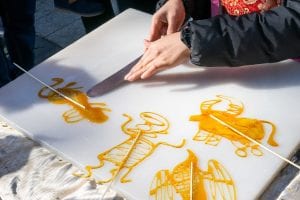
Candied figures 捏糖⼈人 (niē táng rén)
Malt syrup is also a resource for more delicate art. 捏糖⼈人 —literally “squeezed candy people”— have more than 600 years of history. In the winter, they can be seen alongside busy streets and small neighborhoods. Through blowing, stretching, squeezing and use of tools (ex: toothpicks and chopsticks), the malt is shaped into various figures.
In the hands of an experienced maker, the malt can become anything you want.
During Chinese New Year, they’re commonly shaped into the zodiac animal of the year or
auspicious symbols. Not only are they a fun snack, they’re also important cultural artifacts.
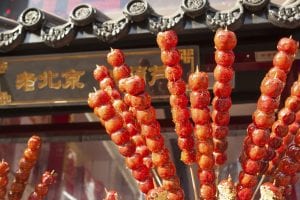 Met with the brisk winter air, the malt hardens quickly. The resulting snack is cold, sweet and sour.
Candied haw is like a magic pill. According to folktales, the favorite concubine of a Song
Dynasty emperor fell sick. None of the imperial doctors knew what to do. The Emperor issued
a public notice for all doctors in the country to come and try.
One prescribed iced candy and red fruit. Everyone was doubtful, but the concubine liked this taste.
They tried it and after eating 10 pieces before every meal for half a month, she really did recover.
Met with the brisk winter air, the malt hardens quickly. The resulting snack is cold, sweet and sour.
Candied haw is like a magic pill. According to folktales, the favorite concubine of a Song
Dynasty emperor fell sick. None of the imperial doctors knew what to do. The Emperor issued
a public notice for all doctors in the country to come and try.
One prescribed iced candy and red fruit. Everyone was doubtful, but the concubine liked this taste.
They tried it and after eating 10 pieces before every meal for half a month, she really did recover.
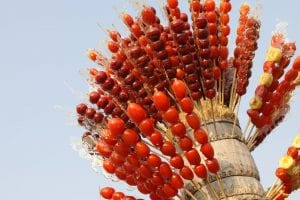
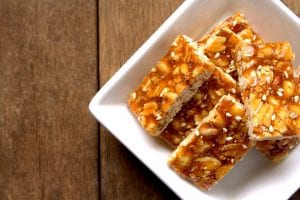

Candied haw 冰糖葫芦 (bīng táng hú lú)
Traditionally a winter-time snack, candied haw can now be enjoyed in any season. Hawthorn ball kebabs are drizzled and coated with malt syrup. The balls can be substituted or added to with red bean paste, walnuts, grapes, begonia fruit and even Chinese yams. Met with the brisk winter air, the malt hardens quickly. The resulting snack is cold, sweet and sour.
Candied haw is like a magic pill. According to folktales, the favorite concubine of a Song
Dynasty emperor fell sick. None of the imperial doctors knew what to do. The Emperor issued
a public notice for all doctors in the country to come and try.
One prescribed iced candy and red fruit. Everyone was doubtful, but the concubine liked this taste.
They tried it and after eating 10 pieces before every meal for half a month, she really did recover.
Met with the brisk winter air, the malt hardens quickly. The resulting snack is cold, sweet and sour.
Candied haw is like a magic pill. According to folktales, the favorite concubine of a Song
Dynasty emperor fell sick. None of the imperial doctors knew what to do. The Emperor issued
a public notice for all doctors in the country to come and try.
One prescribed iced candy and red fruit. Everyone was doubtful, but the concubine liked this taste.
They tried it and after eating 10 pieces before every meal for half a month, she really did recover.

Candied haw (malt sugar coated hawthorn fruit) are a popular new year snack.
Candied haw are usually sold by street vendors, or at tea houses and small restaurants.
In the past, some would carry around a large wooden box or bamboo basket. One side would have
many kebabs stuck in it. The other has a stove, pot, cutting board and knife and ingredients. This
lets him put on a show and make candied haw before curious onlookers.
Peanut candy 花⽣生糖 (huā shēng táng)
Peanut candy is another simple yet ancient snack. The basic ingredients are only peanuts and syrup.
Mixed together and cut into squares, it is a sweet and crispy treat.
Sometimes it is not hardened and retains the texture of strong taffy. Of all the local varieties,
Zherong (柘荣—zhè róng) peanut candy is the most famous. Also made of malt, it is another
offering to sweeten up the Stove God’s mouth. There is a 9 step making process and has a unique taste.
Other types include: cream, black sesame, fruit, lard, and twisted soft candy (扭结软糖—niǔ jié ruǎn táng).
Popped Rice 爆炒⽶米 (bào chǎo mǐ)
Rice is an undeniable part of Chinese cuisine. It can be steamed, cooked, boiled, fermented, stir- fried, pan-fried, and the list goes on!
“Poprice” is made the same way as popcorn, but much healthier.
Rather than drenched in butter, salt or caramel, the popped rice keeps its natural flavor.
It’s a simple and easy snack to make. Children can also play games with the rice, making it
perfect for the Spring Festival atmosphere.
However, many have abandoned this folk snack for more fashionable treats. Now, in addition
to the fresh and aromatic taste, popped rice also brings nostalgic feelings. Fried rice candy is
popular in the Guangxi province of Southern China.
On the Little Year, people will make the candy with popped rice and malt. It represents a year
of wealth and prosperity, and sweet days. The candies are large enough to keep you satisfied
between meals. Crispy and chewy at the same time, it’s loved by adults and children alike.
The traditional making process is complicated and difficult. It includes soaking, steaming,
flattening and popping of the rice. There is now a machine that performs all of those steps.
You can also substitute the customary glutinous rice for short-grain rice.
This simplifies the process, but takes away from the special taste and experience.
During modern Chinese New Year, fried rice candy can be bought at any local store.
Many rural households continue to follow the ancient steps and pass down the
traditional taste.

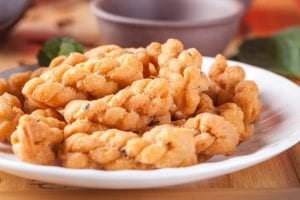
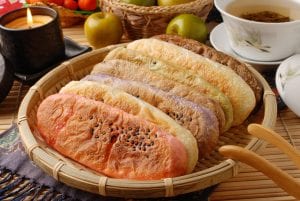
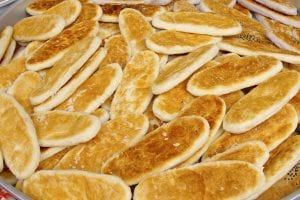
Ginger Candy 糖姜⽚片 (táng jiāng piàn)
Originating from Changsha, ginger candy has been around since the Ming Dynasty. They are created with fresh garlic, white sugar, salt and natural seasoning. After mixing, the candy is put under the sun until it’s entirely dry. In the past, practically every ginger famer would be drying or pickling ginger pieces.
They make great gifts for friends as a small treat.
For those who have colds or stomachaches, the ginger also makes for a quick prescription.
With a unique taste and the ability to warm you up, ginger candy is the best snack for
the winter.
Fried Dough Twists 麻花 (má huā)
In the past, the region of Daying (⼤大营—dà yíng) was supposedly infested with poisonous scorpions. To place a curse on them, every household stretched dough into long strips. They twisted them into the shape of a scorpion’s tail, deep fried it and ate it. With time, these “scorpion tails” transformed into what we now know as fried dough twists (or braided dough). The curse was placed on Lunar February 2. Traditionally, they were eaten on the summer solstice. In modern times, they can be enjoyed anytime you have a craving for it. Rich in protein and low in fat, it’s a good snack for the Chinese New Year.
The basic is just strips of dough twisted together and fried. But of course more can be added to it.
Fried dough twists can be both savory and sweet. They are usually fried until golden. A green
type made from herbs has become popular recently.
The city of Tianjin is known for their twists. They’re made of big and thick strips, filled with other
healthy and tasty ingredients. Of the Tianjin twists, the most well-known are from the 18th Street
(⼗十⼋八街麻花—shí bā jiē má huā). They twist white and gold together. In between, they add
osthmanus blossoms, walnuts, melon slices and more.
Ox Tongue Pastry ⽜牛⾆舌饼 (niú shé bǐng)
This particular pastry is shaped like an ox’s tongue. Dough is rolled into long flat strips and smeared with sauce and sesame seeds before baking.
Ox tongue pastries are a traditional Beijing snack. It has since spread throughout China, becoming
popular in Taiwan, Shanxi and more. As a snack, it can be eaten by itself. The sugary coating gives
enough flavoring. Sometimes, it can also be eaten with fried dough (油条—yóu tiáo). They can even
be filled with stir-fried meat and onion (葱爆⾁肉—cōng bào ròu). The pastries from Yilan and Lukang,
both cities in Taiwan, have especially large differences.
Yilan ox tongue pastry 宜兰⽜牛⾆舌饼 (yí lán niú shé bǐng)
The characteristics of these pastries are: narrow, long, thin and crunchy. A long cut is made in the middle of the pastry. With no filling, they’re more like crackers. The dough is mixed with honey and sugar, giving it a very sweet taste. Some pastry makers also add in milk and cream.Lukang ox tongue pastry ⿅鹿港⽜牛⾆舌饼 (lù gǎng niú shé bǐng)
While the dough is similar to Yilan pastries, these also include a malt filling.
The characteristics of these pastries are: wide, short, thick and soft.
After wrapping in the malt, the balls are flattened into small eggs. They can then be pan-fried or baked.

Persimmon Cakes 柿饼 (shì bǐng)
While waiting for midnight on New Year’s Eve, many will snack on some persimmon cakes. Fruits are always an auspicious treat. Persimmons (柿⼦子—shì zǐ) represent the phrase “everything goes according to your wishes” (事事如意—shì shì rú yì) because of the pun for the word “shì.” There was also a king named Zubing (祖丙—zǔ bǐng) who was well loved by his people. After his death, the people chose lunar December 5 as the memorial day. Persimmon cakes were used as offerings because the name sounds similar to 思丙 (sī bǐng)—to commemorate Zubing.
To be made into cakes, persimmons must be skinned, dried, flattened and frosted.
Farmers believe that cakes made when real frost appears have the best taste. If dried further,
they become dried persimmons (a boring name) and the white powder that forms is called
“persimmon frost.”

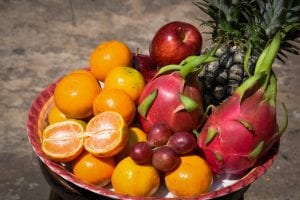

The color may not be the most appealing, but you won’t be able to stop eating them.
But be careful! Eating too many persimmons can cause stomachaches.
Fruit Platter ⽔水果盘 (shuǐ guǒ pán)
Of course, persimmons are not the only fruit with a special meaning.
A platter is usually offered to the ancestors and gods, in addition to being snacked on.
Dried fruits are most common in the season. If you’re looking to create a platter full
of blessings, here are some you can include:
- Kumquats, tangerines, oranges: Because of the golden color, these fruits represent wealth and prosperity. 桔 (jú) also looks similar to 吉 (jí), which means luck and auspiciousness.
- Peaches: They are said to be the fruit of the gods. They represent longevity and health.
- Grapes: Grapes come in bunches. They represent bountiful harvests.
- Pomegranates: This fruit represents a large family, the ultimate blessing for most Chinese. In Chinese culture, you must respect your parents. And the most important thing you must do to show respect is passing down the family name. Most Spring Festival dishes and desserts have legendary origins and symbolic meanings. While it’s less heavy with snacks, they’re full of the flavors and memories of childhood. In our modern fast-paced lifestyle, it’s a treat itself to slow down, eat some snacks and reconnect with family.

